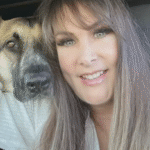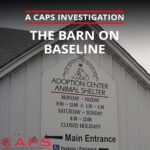Breeder: Raber, Ken
Address: 2436 N 750 E
City, State Zip: Montgomery, IN
Year: 2007
USDA License: UNLICENSED
Date of CAPS Investigation: 2007-10-08
CAPS investigators went to this property on October 8, 2007 when another breeder in the area gave us Ken Raber’s address. On the left side of the driveway leading up to the house was a large pond, beside which was a small building and a fenced-in pen that housed approximately ten dogs of various small breeds. We were not able to access this area, but from several hundred feet away we were able to count several dogs.
We followed Ken Raber past his residence and along a path of tarp to a wooded area behind the house. About halfway down the path was a wooden kennel that housed several Beagles in elevated cages made of wire, positioned on the kennel side facing us. There were at least three cages on this side of the structure, possibly four – all of which contained empty water dishes (3.10-Watering).
More than 24 hours’ of fecal accumulation had built up beneath these cages (3.11(a)-Cleaning of primary enclosures), and flies swarmed the dogs (3.11(d)(4)-Pest control).
The opposite side of this building also had three or four cages, but it was unclear whether dogs were currently housed on this side of the kennel. Bowls were present in these cages, but no dogs were seen.
To the left of this building was a Beagle tied to a tree – at least the fourth Beagle, possibly the fifth, on the property (3.6(c)(4)-Prohibited means of primary enclosure). This dog did not have any evident source of water (3.10-Watering).
Kennel building
At the end of the path was a double-decker-style kennel building that housed approximately 12 to 15 dogs. Raber had one male Boston terrier and at least three females of the same breed that he wanted to sell to us. He said if we didn’t buy them, he knew another man who wanted to a few weeks later. He also wanted to sell a female Miniature Pinscher as a pet because it was too small to breed and another Min Pin whose gender we did not learn.
Other cages in the kennel housed Chihuahuas – one of unknown gender and another that was obviously bred. The bred Chihuahua appeared to be suffering from advanced hair loss (2.40-Vet care), documented in the footage taken at the property. This dog was a brownish, tan color, but pink skin was prominent, as there was very little fur on the dog’s body at all. The small amount of fur it did have was present only in patches.
The pregnant dog’s cage was coated in fecal accumulation that did not drop through the wire flooring (3.11(a)-Cleaning of primary enclosures), and flies were evident throughout.
In a cage on the upper level was a small dog that appeared to be a Pomeranian, as along with a Shih Tzu with some fur matting (2.40-Vet care).
At the end of the left-hand side of the lower level was a white and black female dog, presumably a Papillon, with a young puppy that appeared to be only four to five weeks old. This puppy was curled into a ball in the corner of the cage, fully exposed to feces on the cage floor (3.11(a)-Cleaning of primary enclosures) and swarming flies (3.11(d)(4)-Pest control).
Another dog of an unknown breed was housed in a cage on the upper level. Yet another cage appeared to house another Pomeranian, but the dog was too frightened to do more than stick its head through the metal dog door into the outdoor portion of the cage.
Beneath the cages in the double-decker kennel were plastic platform trays that collected the urine and feces that fell through the wire floorings. This tray was intended to be sprayed down, pushing the excrement out from below the dogs. Instead, the tray contained a large accumulation of feces directly below the dogs and urine that had been sitting for so long that it had partially solidified (3.11(a)-Cleaning of primary enclosures). This waste accumulation had attracted flies that swarmed around the dogs (3.11(d)(4)-Pest control).
Unlicensed sales
In total, we counted at least six dogs that were known to be female. This number does not include the Shih Tzu, the Pomeranian, the first Chihuahua, the four Beagles, the second Miniature Pinscher, the dog of unknown breed, and any of the dogs housed in the fenced-in pen on the front of the property by the pond. It is unlikely that any breeder would house that many male dogs, as most kennels contain far more females than males for breeding purposes.
Ken Raber told us that he could sell us dogs but would have to check with his broker, Levi Graber, in order to determine what he could sell to the public. Raber is clearly operating a kennel without a license and selling to a broker in a nearby town. He exceeds the three-bitch limit; therefore, his facility should be licensed and subject to USDA inspection.




